World language
A world language is one that is spoken internationally and learned and spoken by numerous people as a second language. A world language is characterized not only by the total number of speakers (native and second language speakers) but also by geographical distribution and its use in international organizations and diplomatic relations.[1][2]

The most widely spoken world language today is English, with millions of second-language users worldwide. French is also similarly categorized as a world language.[3]
Other possible world languages include Spanish, Arabic, Russian, and Mandarin Chinese.[4]
World languages are differentiated from supra-regional languages - a world language has worldwide, global, distribution but a supra-regional language only has functional use, limited to a specific geographical area it is spoken. Portuguese and German are some supra-regional languages.
Historically, Ancient Greek, Latin, Classical Chinese, Sanskrit, Classical Arabic, and to a limited extend Biblical Hebrew and Old French, have also functioned as world languages due to their previous standings as lingua francas over large parts of the world[5].
Overview
Arabic
Arabic gained international prominence because of the medieval Islamic conquests and the subsequent Arabization of the Middle East and North Africa, and it is also a liturgical language amongst Muslim communities outside the Arab World.
Standard Mandarin
Standard Mandarin is the direct replacement of Classical Chinese, which was a historical lingua franca in East Asia, also referred to academically as the East Asian cultural sphere in terms of culture, until the early 20th century, and today serves as a common language between speakers of other varieties of Chinese not only within China proper (between the Han Chinese and other unrelated ethnic groups), but in overseas Chinese communities. It is also widely taught as a second language internationally. Standard Mandarin is also an official language in many international organizations such as the United Nations, ASEAN, and the Shanghai Pact, etc.
Classical Chinese
Classical Chinese used to be a historical common language in East Asia or the Sinosphere. It was usually used as a written language in official documents and letters.
English
In addition to 370 million native speakers, English is estimated to have over 610 million second-language speakers,[6] including anywhere between 200 and 350 million learners/users in China alone,[7] at varying levels of study and proficiency, though this number is difficult to accurately assess.[8] English is also increasingly becoming the dominant language of scientific research and papers worldwide, having even outpaced national languages in Western European countries, including France, where a recent study showed that English has massively displaced French as the language of scientific research in "hard" as well as in applied sciences.[9] It is the most common of the languages used on the Internet. As of 2019, according to one survey, English is used by 54% of the world's top 10 million websites,[10] and according to another survey, 25.5% of all Internet users are English speakers.[11]
French
During the 19th and early 20th centuries, French was the language of communication and diplomacy, and the favoured second language among the elite and the educated classes in Europe (including Russia, Romania, Bulgaria, and Greece) — as well as in many Middle East and North African countries such as Syria, Egypt, Ottoman Turkey and Iran. In addition, French enjoyed high status in its colony in Indochina, and in several South American ones like Argentina, Brazil, Chile, and Uruguay. However, French has declined steadily since World War I, being gradually displaced by English - although in Lebanon, Tunisia, Algeria and Morocco, French continues to be the favoured second language, as well as enjoying co-official status in Canada, Switzerland and Belgium. Moreover, French still remains one of the working languages of many international organizations, including the United Nations, NATO, European Union and NAFTA. French is the principal working language of the European Court of Justice. French is also internationally recognized to be of high linguistic prestige, still used in diplomacy and international commerce, as well as having a significant portion of second language speakers throughout the world.[12]
German
German, although it had many different dialects which formed a language continuum from Holland and Flanders in the northwest, through Schleswig in the north across to East Prussia in the northeast, down to Styria and Lower Austria in the southeast and Bern and South Tyrol in the south, served as a lingua franca in large portions of Europe for centuries, mainly within the Holy Roman Empire and the eastern areas of the Kingdom of Prussia (which later included additional areas of previously Polish territory), and later within the Austro-Hungarian Empire and other areas where Germans settled, such as the Baltic States and Transylvania. It remains an important second language in much of Central and Eastern Europe, and in the international scientific community. It is the most widely spoken native language in the European Union as well as one of the three "procedural languages" of its institutions alongside English and French.[13] As of 2019, it is the third most commonly used language for website content, with 5.8% of the world's top 10 million websites using it,[10] and 2.1% of all Internet users are German speakers.[11]
Portuguese
Portuguese is the sole official language of Portugal, Angola, Mozambique, Guinea-Bissau, Cape Verde, São Tomé and Príncipe, and Brazil while having co-official language status in East Timor, Equatorial Guinea, and Macau.
Russian
Russian is the largest native language in Europe, the most geographically widespread language in Eurasia,[14] one of the six official languages of the United Nations, and one of two official languages aboard the International Space Station. As of 2019, it is the second most commonly used language for website content, with 5.9% of the world's top 10 million websites using it,[10] and 2.5% of all Internet users are Russian speakers.[11]
Russian was used in the Russian Empire and the Soviet Union, and its teaching was made compulsory in the Eastern Bloc countries. However, the use and teaching of Russian has declined sharply in both the former Eastern bloc and the near abroad since the break up of the Soviet Union and Russia's deputy education minister was quoted as saying in December 2013 that the number of Russian speakers had fallen by 100 million since that date.[15][16][17] It is still widely spoken throughout the Caucasus, Central Asia, Eastern Europe and the Baltic states.
Spanish
Spanish is the world's second-most spoken native language, after Mandarin Chinese. Spanish was used in the Spanish Empire and today is in use in Spain, in Latin American countries (except Brazil, French Guiana and Haiti), and is widely spoken in many parts of the United States, particularly in Florida and the states that border Mexico. As of 2011, around 13% of the US population spoke Spanish fluently.[18] Indeed, by 2016 Spanish was the most widely taught non-English language in American secondary schools and schools of higher education.[19] It is also an official language of the United Nations. As of 2019, Spanish had the third-largest number of internet users by language with 7.9%, after English with 25.2% and Chinese with 19.3%.[11]
Historical Development
Historical development of World Languages could be traced through the development of Classical Languages. Classical languages are most often dead languages, but it had subsequently influenced development of modern world languages. Ancient Greek, Latin, Classical Chinese, Sanskrit, Classical Arabic, and to a limited extend Biblical Hebrew and Old French, are well known languages used during ancient times for cultural, administrative and literary purposes.
Ancient Greek was the primary language of the Seleucid Empire, the Greek state that existed after the death of Alexander III of Macedon, and a geographically vast empire that, at its height, spanned Anatolia, Persia, the Levant, Mesopotamia, and what are now Kuwait, Afghanistan, and parts of Turkmenistan. At this period, it had evolved into Koine Greek, or common greek, the common supra-regional form of Greek spoken and written during the Hellenistic period, the Roman Empire and the early Byzantine Empire. It has contributed many words to English vocabulary and has been a standard subject of study in educational institutions of the Western world since the Renaissance. Greek also had influence on development of the Latin script. Koine is also the language of the Christian New Testament, of the Septuagint (the 3rd-century BC Greek translation of the Hebrew Bible), and of most early Christian theological writing by the Church Fathers.
Latin was the official language of the Roman Republic and the Roman Empire, one of the largest historical polities in the ancient world. It was also a transcontinental polity which endured for more than a millennia. Latin was the language of international communication, scholarship and science until well into the 18th century, when vernaculars (including the Romance languages) supplanted it. Ecclesiastical Latin remains the official language of the Holy See and the Roman Rite of the Catholic Church. In particular, Latin (and Ancient Greek) roots are used in English descriptions of theology, the sciences, medicine, and law
Classical Chinese was the main form used in Chinese literary works until the early 20th century, and was also used extensively in Japan, Korea, and Vietnam. Most government documents in the Republic of China were written in Classical Chinese until reforms in the 1970s, in a reform movement to shift the written style to vernacular Chinese.

The Sanskrit language's historic presence is attested across a wide geography beyond South Asia. Inscriptions and literary evidence suggests that Sanskrit language was already being adopted in Southeast Asia and Central Asia in the 1st millennium CE, through monks, religious pilgrims and merchants. Sanskrit has been the predominant language of Hindu texts encompassing a rich tradition of philosophical and religious texts, as well as poetry, music, drama, scientific, technical and others. It is the predominant language of one of the largest collection of historic manuscripts. The earliest known inscriptions in Sanskrit are from the 1st century BCE.
Classical Arabic or Quranic Arabic is the standardized literary form of the Arabic language used from the 7th century and throughout the Middle Ages. It was the main language used in the Rashidun and the Umayyad Caliphate during the era of Muslim conquests, and in the Abbasid Caliphate. It is present most notably in Umayyad and Abbasid literary texts, such as poetry, elevated prose, and oratory. Modern Standard Arabic is its direct descendant used today throughout the Arab world in writing and in formal speaking.

Biblical Hebrew is an archaic form of Hebrew, spoken by the Israelites in the area known as Israel, roughly west of the Jordan River and east of the Mediterranean Sea. The primary source of Biblical Hebrew material is the Hebrew Bible, which was later translated to Greek (the Septuagint). The content established canon used in the Bible. The Bible has had a massive influence on literature and history, especially in the Western world, where it was the was the first book printed using movable type. According to the March 2007 edition of Time, the Bible "has done more to shape literature, history, entertainment, and culture than any book ever written. Its influence on world history is unparalleled, and shows no signs of abating." With estimated total sales of over 5 billion copies, it is widely considered to be the best-selling book of all time.
The region where Old French was spoken natively roughly extended to the northern half of the Kingdom of France and its vassals (including parts of the Angevin Empire, and the duchies of Upper and Lower Lorraine to the east (corresponding to modern north-eastern France and Belgian Wallonia), but the influence of Old French was much wider, as it was carried to England and the Crusader states as the language of a feudal elite and commerce. Old French also had an irreversible and permanent impact on the English language after the Norman Conquest of England, when it displaced Old English in England as the language of the ruling class.
Living world languages
Some sources[20][21] define a living world language as having the following properties:
- numerous speakers
- a substantial fraction of non-native speakers (function as lingua franca)
- official status in several countries
- use across several regions in the world
- a linguistic community not defined strictly along ethnic lines (multiethnic, pluricentric language)
- one or more standard registers which are widely taught as a foreign language
- association with linguistic prestige
- use in international trade relations
- use in international organizations
- use in the academic community
- significant body of literature
Languages which are often considered world languages include:[1][22][23]
| Language | Family | Branch | Writing system | First language (L1) | Second language (L2) | Total No. of speakers |
Geographical distribution | Official status distribution | Global distribution map |
|---|---|---|---|---|---|---|---|---|---|
| English | Indo-European | Germanic | English (Latin) alphabet | 369.7 million | 898.4 million | 1.268 billion[25] | Geographical distribution of English speakers | List of territorial entities where English is an official language | .svg.png.webp) |
| French | Indo-European | Romance | French (Latin) alphabet | 77.3 million | 199.3 million | 276.6 million[26] | Geographical distribution of French speakers | List of territorial entities where French is an official language | 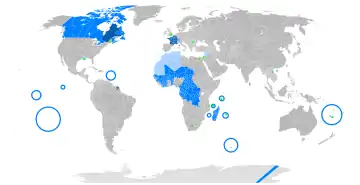 |
Other sources denote the following languages as world languages, whilst stricter sources list them only as supra-regional languages:[2]
| Language | Family | Branch | Writing system | First language (L1) | Second language (L2) | Total No. of speakers |
Official status distribution | Global distribution map |
|---|---|---|---|---|---|---|---|---|
| Spanish | Indo-European | Romance | Spanish (Latin) Alphabet | 463.0 million | 74.9 million | 537.9 million[28] | List of countries where Spanish is an official language | 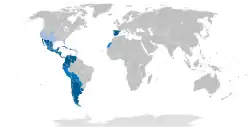 |
| Arabic | Afro-Asiatic | Semitic | Arabic abjad | — | — | 335.2 million[29] | List of countries where Arabic is an official language | 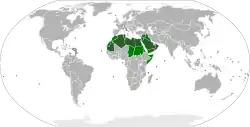 |
| Russian | Indo-European | Slavic | Russian (Cyrillic) alphabet | 153.6 million | 104.3 million | 258.0 million[30][31] | List of territorial entities where Russian is an official language | 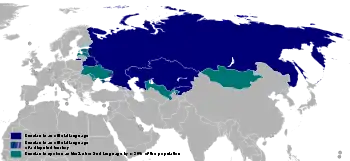 |
| Mandarin Chinese | Sino-Tibetan | Sinitic | Chinese characters | — | — | 1.324 billion[32] | List of territorial entities where Chinese is an official language | 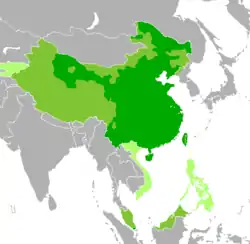 |
Other supra-regional languages
Other supra-regional languages include:
| Language | Family | Branch | First language (L1) | Second language (L2) | Total No. of speakers |
Official status distribution | Global distribution map |
|---|---|---|---|---|---|---|---|
| Portuguese | Indo-European | Romance | 227.9 million | 24.2 million | 252.2 million[34] | List of territorial entities where Portuguese is an official language |  |
| German | Indo-European | Germanic | Standard: 75.5 million[lower-alpha 1] | Standard: 56.1 million[lower-alpha 1] | Standard: 131.6 million[lower-alpha 1] | List of territorial entities where German is an official language |  |
See also
Notes
- In contrast to other pluricentric languages (e.g., Arabic or Malay), Ethnologue only lists "Standard German", thereby excluding Swiss German and numerous other varieties of German.[35] Summing up Standard German as well as all undisputed German dialects/varieties (see ISO-list in infobox at German language) that are not listed under "Standard German" results in ca. 90 M native speakers. Furthermore, Ammon (2014)[36] points out that Ethnologue overestimates L2 speakers, thus underestimating L1 speakers, in Germany by 5M --> 95M L1 speakers.
References
- Fischer Weltalmanach. S. Fischer Verlag. Archived from the original on September 4, 2009.
- Baker, Colin; Jones, Sylvia Prys (1998). Encyclopedia of Bilingualism and Bilingual Education. Multilingual Matters. ISBN 9781853593628 https://books.google.com/books?id=YgtSqB9oqDIC. Missing or empty
|title=(help) - https://ask.un.org/faq/14463
- https://www.un.org/en/sections/about-un/official-languages/index.html
- Sapir, Edward (1921). Language: An introduction to the study of speech. New York: Harcourt, Brace and Company. p. 164. ISBN 4-87187-529-6. Retrieved February 17, 2006.
- Wei, Rining; Jinzhi Su (2012). "The statistics of English in China". English Today. 28 (3): 10–14. doi:10.1017/s0266078412000235.
- Crystal, David (2006). "9 - English worldwide". In Hogg, Richard; Denison, David (eds.). A History of the English Language. Cambridge University Press. pp. 420–439.
- Héran, François (June 2013). "No English please! Survey on the languages used for research and teaching in France" (PDF). Population & Sociétés (501).
- "Usage Statistics of Content Languages for Websites". W3Techs. Retrieved July 14, 2019.
- "Number of Internet Users by Language". Internet World Stats. Retrieved 2019-07-14.
- "Official Languages". United Nations. Retrieved 2016-10-29.
- "European Commission - Press releases - Frequently asked questions on languages in Europe". europa.eu. Retrieved 2017-03-11.
- "Russian: Eurasia's Most Geographically Widespread Language". Day Translations Blog. 4 August 2014.
- Blank, Stephen (9 January 2015). "Russia's Waning Soft Power in Central Asia". The Diplomat.
- "Kyrgyzstan's Russian-Language Teaching Getting Squeezed Out". Eurasianet. 15 December 2014.
- Brooke, James (17 October 2012). "English Replaces Russian as Top Foreign Language of Study in Ex-Soviet Georgia". VOA News.
- Language Use in the United States: 2011 (Table 3, p.9). Census.gov.
- Goldberg, David; Looney, Dennis; Lusin, Natalia (February 2019), Enrollments in Languages Other Than English in United States Institutions of Higher Education, Summer 2016 and Fall 2016: Preliminary Report (PDF), Modern Language Association of America, retrieved March 4, 2019
- "What Is a World Language? (with pictures)". wisegeek.com.
- Wallraff, Barbara. "What Global Language?".
- Ammon, Ulrich (1989). Status and Function of Languages and Language Varieties. W. de Gruyter. ISBN 9780899253565.
- Mazrui, Ali AlʼAmin (1976). A World Federation of Cultures: An African Perspective. Free Press.
- "Summary by language size". Ethnologue. Retrieved 2019-03-01.
- English at Ethnologue (22nd ed., 2019)
- French at Ethnologue (22nd ed., 2019)
- "Summary by language size". Ethnologue. Retrieved 2019-03-01.
- Spanish at Ethnologue (22nd ed., 2019)
- Arabic at Ethnologue (22nd ed., 2019)
- Russian at Ethnologue (22nd ed., 2019)
- https://blog.lingoda.com/en/most-spoken-languages-in-the-world-in-2020
- Chinese at Ethnologue (22nd ed., 2019)
- "Summary by language size". Ethnologue. Retrieved 2019-03-01.
- Portuguese at Ethnologue (22nd ed., 2019)
- German, Standard at Ethnologue (22nd ed., 2019)
- Ammon, Ulrich - Die Stellung der deutschen Sprache in der Welt (de Gruyter Mouton; ISBN 978-3-11-019298-8)
Bibliography
- Christian Mair (ed.), The Politics of English As a World Language (2003), ISBN 978-90-420-0876-2.
- Mario Pei, One Language for the World (1958), ISBN 978-0-8196-0218-3.
- Anne-Marie De Mejía, Power, Prestige, and Bilingualism: International Perspectives on Elite Bilingual Education (2002), ISBN 978-1-85359-590-5.
- David Crystal, English as a Global Language (2003), ISBN 978-0-521-53032-3.
- Clare Mar-Molinero, The Politics of Language in the Spanish-speaking World (2000), ISBN 978-0-415-15655-4.
- George Weber, The World's 10 most influential Languages
